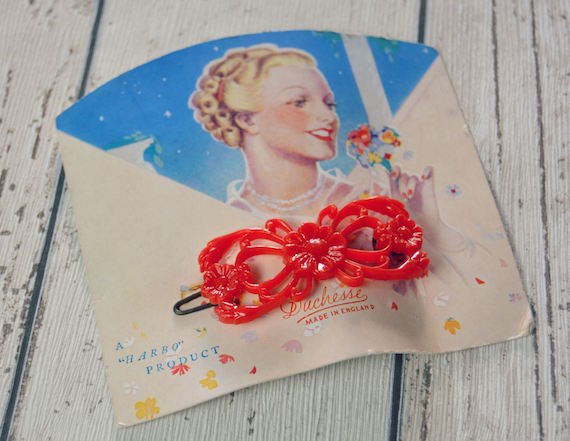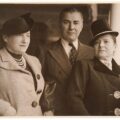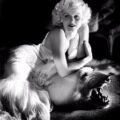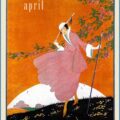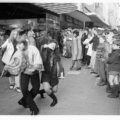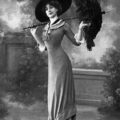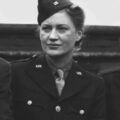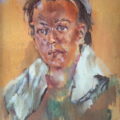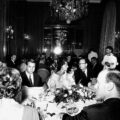Vintage fashion – for fashion lovers
October 16, 2015Owning vintage fashion is many things simultaneously. It’s the chance to own a piece of clothing that probably very few other people in the world have:
it’s the chance to ignore the usual rules of space and time and be someone else for a while – a girl of the Swinging Sixties on King’s Road in London, an American Fifties bobby soxer, a 20s French Flapper, a Forties Housewife, a punk, a spiv, a zoot suited rebel, a hippie, a grunge kid, a beatnik…
and if you don’t want to be an average joe on the street you can be Audrey Hepburn today in Breakfast at Tiffany’s, in a simple black sheath and pearls. You could be Marilyn Monroe in a beaded wiggle dress, or Cary Grant looking suave.
Unique Vintage fashion
Or of course, you could just be you, with your own unique fashion sense. Trawling the High Street rarely turns up the unexpected gems that you find with vintage fashion. You may really have a thing for sparkle, and vintage fashion will surely give you that fix, and for much less money than a chain store.
Some seasons, there’s no glitter in sight, and then what’s a dedicated glitter aficionado to do? Of course, you can substitute the word glitter here for, I don’t know, suede, lace, velvet, PVC, ruby-red, pencil skirt, etc. The ideal pencil skirt is not often found on a High St, but look in a good vintage store and chance are, you’ll hit your mark.
vintage fashion dead-stock
The other thing that is so fascinating about vintage fashion is less about you as a buyer, more about the clothes themselves and their previous owners. For some people this is a bit contentious – they don’t want to wear “dead people’s clothes”. For you people, try looking for vintage dead-stock – clothes and accessories that have never been worn and are usually in packaging, just really, really old.
Often they’ve been bought out as a shop closes down in decades gone by, then put into storage and forgotten about until for some reason the storage is cleared out and voila! Brand new vintage. If you are lucky they will even be unfaded and showing original colours.
vintage fashion wonders
But if you like the sense of history inherent in vintage fashion, then picturing the person who wore this garment last is wonderful. What kind of life did they live and where?
vintage fashion history
Fashion history wouldn’t be what it is without vintage fashion items, of course. Studying vintage fashion shows us construction techniques, design, and details about fabric weaving and dyes.
You don’t have to be a fashion historian with a PHD to appreciate these details. Fashion dead-stock often provides interesting details of packaging design, too. It helps fashion designers in thinking up new collections, and handling actual clothes is interesting and provides a level of detail beyond looking at photographs or drawings can (although putting the whole picture together helps). So you don’t even have to collect vintage fashion in your own size or style for it to be fascinating.
Career Paths in vintage fashion
They say that one of the best routes to happiness is to do a job that you love. If you are interested in vintage fashion, whether that’s watching old films and marvelling over the costumes, reading books about vintage clothes, or wearing vintage dress yourself, have you considered actually working in the field?
You don’t have to have your own perfect pin-up girl look to work in the field or fit into a vintage size. You don’t even have to be female – many men work in the area too, and mens vintage clothing is just as fascinating as womens. You just have to love all or any aspects of clothing vintage.
Some jobs to consider: fashion writer, fashion historian, fashion consultant, historic fashion consultant for films and authors, costume designer, film historian, fashion designer art gallerists, photography curator, photographer, model. Of course, many who are interested in this field also open their own shops.
About being a fashion writer
Fashion writers are required for newspapers, magazines, books about fashion, and online articles. Often the requirement is that you are a native speaker in whatever language you choose to write.
You need to pay attention to the style of the publication you are writing for. Some places want lengthy, articulate articles, and some short and pithy. Sometimes you will be asked to source images, and sometimes these will be provided.
You may need to learn layout, how to upload articles, and even code if you will be working online. The client may provide the title for the article or they may wish you to suggest your own.
About being a costume designer
Costume design is an excellent job for those interested in vintage fashion. It is often important, particularly in a historical play or film, to carefully study all aspects of clothes from different eras. Womens shirts, coats, bags, dresses, shoes and accessories and every aspect of their clothing helps to build the character. And you may want to design the outfit of your dreams, but you have to consider: would that particular woman wear it? Perhaps she just isn’t the sort.
If the script calls for a dowdy and old-fashioned housewife, that’s what the costumes must look like. Perhaps your next production will feature a countess!
About running a vintage shop
The first thing you need to decide is do you want a bricks and mortar shop or are you going to do this online? Or maybe both?
Then you need to think about where you will get your stock from. Think about what you want to specialise in – items from a particular era? Womenswear? Menswear? Children’s wear? Maybe accessories like hats, bags and shoes will be on sale. Or you could specialise in rare, special edition clothing. Vintage fashion comes in so many guises it’s sometimes hard to narrow it down.
Once you have decided where your passion lies, you need to get in some stock and then think about promotion. It’s really good to get some photos of the clothes on models. These will be good for adverts, posters, and as graphics if you’re working online. You do not have to photograph every single item of stock you own on a model, as this can be expensive. Some of the photos can be flat.
Have a look at shops you admire to see how they do it. Then open your shop for sale and watch the clothes get snapped up!
About being an fashion historian
Many fashion historians work in museums. Some go to private collections. Some write books about fashion or consult for films or TV. Their main job is to learn everything they can about the clothes they are interested in. Often they stick to a particular era.
Choosing a very narrow specialism means you are very likely to be one of the only specialists n the field. Many fashion historians can get very passionate about men’s shirt cuffs of the 18th century, or limited edition working class aprons.
Studying history via clothing can be absolutely fascinating. You will find out a lot about the person who wore the clothes. You will also find out about other people’s lives at that point in time. Fashion history tells us about class, economics, work, travel and leisure.
Explore Vintage Street Wear – Everyday vintage fashion is making a comeback
With today’s vintage fashion designers and clothiers taking inspiration from mid-century clothing, vintage-inspired street clothes are becoming ever popular
Vintage fashion isn’t just for special occasions or catwalks anymore – Today, vintage clothes are in full display on the streets everywhere!
The 1940s and 50s were simpler times; but they have left an indelible mark of inspiration on vintage fashion designers up to the present day. What used to be whimsical just a few years ago however, for instance a special occasion getup, or retro skirts and dresses worn for special events, have now spilled out on the streets of London, Paris and in every major western capital.
What’s in a name?
Vintage street style, retro street wear, period street fashion – all of these names are becoming more popular in today’s fashion lexicon. While the names may differ depending on where you go are whom you may be speaking with, the results of what that name stands for are visible out in the streets across the fashion-conscious world.
From the streets of London, to New York and Paris, you’ll see ordinary people – working moms, bank clerks, store assistants, housewives – wearing vintage clothes that are reminiscent of a bygone era. From the nipped-in high waist tops, padded shoulders and a-line skirts of the 1940s, to the New Look of the 1950s and every type of fashion statement made in between; you’re sure to come across it all out in the streets these days.
What’s different though is that, while these items all have a familiar label to them – vintage, period, retro – and look markedly similar to the skirts and dresses worn by “commoners” of that era; they aren’t the same!
New twist to old favourites
Even though modern-day retro street fashion pieces come in all different shades, sizes and designs, vintage-inspired garments have been made distinctly contemporary by today’s designers. As a result, when you wear them, they don’t look like you’re wearing collectibles. Rather, by putting a modern day twist on vintage fashion pieces, today’s designers make your ensemble fit right into the everyday clothing line-ups you see on the streets.
Today, vintage fashion ideas are grounded in items that were popular back in the 1940s, 50’s and 60s, with designers being inspired by mid to turn-of-the-century patterns, prints and designs. However, while vintage-inspired clothing designs have maintained the overall silhouettes of the time, they include some elements that are more in vogue today.
For instance, today’s period-inspired vintage fashion designers have gone lighter on detailed trims for their retro dresses and skirts. And where tight, figure-hugging designs were the “in thing” back in the day, today’s vintage clothes seen on the streets have a much looser and more comfortable fit to them.
And while today’s designers aren’t completely different from their peers of yesteryears, they do have a wider selection of materials and resources to work with; and that makes it easier for putting a contemporary stamp on vintage fashion designs seen on the streets today. Way back then, largely because fabrics were a luxury item, you had vintage streetwear that came in limited sizes. Today, you have garments that can fit almost every conceivable figure, built and body-type!
Mid-century London
Back in mid-century London, it seemed like everyone on the street was dressed in the same colour, or shades that were not completely identical but similar. Most of the skirts, dresses and blouses – and even men’s fashion pieces – were produced in limited palettes. Prints were largely seen in children’s wear or special-event clothing. That’s all changed in today’s retro street fashion.
Today’s vintage inspired streetwear designers are using bold colour combinations, including judicious inclusion of black and whites, stripes, cheques, bright prints and contrasting colours. English-made garments from La Riviera Clothing, London, for instance, feature Grey stripes, Navy, Mint, Pink, Black, Bright red, Cream, Royal blue, Yellow checks, Orange, Green…and almost every other colour, shade and hue in the universe.
And if you scan the vintage fashion scene for street wear of the 70’s, 80’s and 90’s, you’ll find styles, designs and colours from industry leaders like Levi, Nike, J.Crew and Ralph Lauren, that have been “revived” and live on even today in the form of contemporary vintage inspired fashion.
Made to fit
The great thing about today’s vintage street wear is that you don’t really need to go on a scavenger hunt all across the city to locate collectibles or rare pieces of retro wear. And you don’t have to browse through period vintage fashion stores all over town to get that perfect piece for your wardrobe. With today’s vintage inspired clothing line-ups, you’ll be able to find the ideal combination of clothes to give you the perfect street-look of the 1940s, 50s and 60s.
The best thing about today’s period-inspired clothing is that you won’t have to look as though you have put on a costume. Contemporary vintage fashion designers throughout London and other fashion centers are creating bold new looks that mimic retro style designs, but with a modern twist. They use today’s fabric and design technology to put their own spin on mid-century street wear.
And if you are great fan of vintage fashion street wear, you don’t even have to worry about whether some of the items in your line-up will fit you perfectly. Today’s designers are inspired by trends and tendencies that are rooted in a bygone era, but their vintage clothes are created to fit modern bodies. In all likelihood, you’ll find vintage-inspired street dresses, skirts and blouses that fit you to a T!
A gorgeous 1950s drawing – but is it enough
You want to be Cary Grant?
How about a wiggle dress like Marilyn?
Audrey Hepburn – It’s a good look.




